Cantaloupe contains vitamin C, vitamin A, beta-carotene, manganese, and lots more nutrients.
Cantaloupe contains vitamin C, vitamin A, beta-carotene, manganese, and lots more nutrients.
This fantastic recipe comes from Natalia Star of Oceanica Wellness. Natalia has created a masterpiece that is nearly too pretty to eat.
Ingredients: Carrots, alfalfa sprouts, broccoli, sun dried tomatoes, extra virgin olive oil, fresh lemon juice, paprika, kale.
Preparation instructions: shred two large carrots and a small head of broccoli. In a large bowl, mix the aforementioned shreddings with some alfalfa sprouts, sun-dried tomatoes, extra virgin olive oil, freshly squeezed lemon juice, and paprika. Press the mixture into the shape that you like, and top with more sun-dried tomatoes. Surround it with small bouquets of kale. Enjoy!
Natalia is the founder of Oceanica Wellness. Her writing is uplifting and inspirational. She wants to help you to enjoy a healthy lifestyle and is my co-hostess in our 7-day Raw Vegan Challenge.
Esta fantástica receta viene de Natalia Star de Oceanica Wellness. Natalia ha creado una obra maestra que es casi demasiado bonito para comer.
Ingredientes: zanahorias, brotes de alfalfa, brócoli, tomates secados al sol, aceite de oliva extra virgen, jugo de limón fresco, pimentón paprika, col rizada.
Instrucciones de preparación: triturar dos zanahorias grandes y una pequeña cabeza de brócoli. En un tazón grande, mezcle los shreddings mencionados con algunos brotes de alfalfa, tomates secos, aceite de oliva virgen extra, zumo de limón recién exprimido, y el pimentón. Presione la mezcla en la forma que te gusta, y encima con más tomates secados al sol. Rodea con pequeños ramos de la col rizada. Disfrute!
Natalia es el fundadora de Oceanica Wellness . Su escritura es edificante e inspirador. Ella quiere ayudarle a disfrutar de un estilo de vida saludable y es mi co-anfitriona en nuestro Desafío Crudi-Vegana de 7 días.
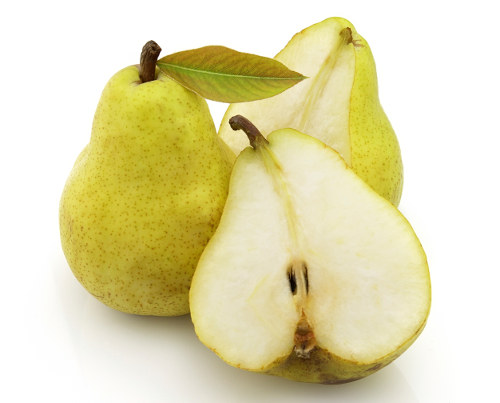
Pears contain vitamins B, C, E and K, plus calcium, iron, magnesium, phosphorus, potassium, sodium and zinc.

Las peras contienen vitaminas B, C, E y K, mas calcio, hierro, magnesio, fosforo, potasio, sodio y zinc.
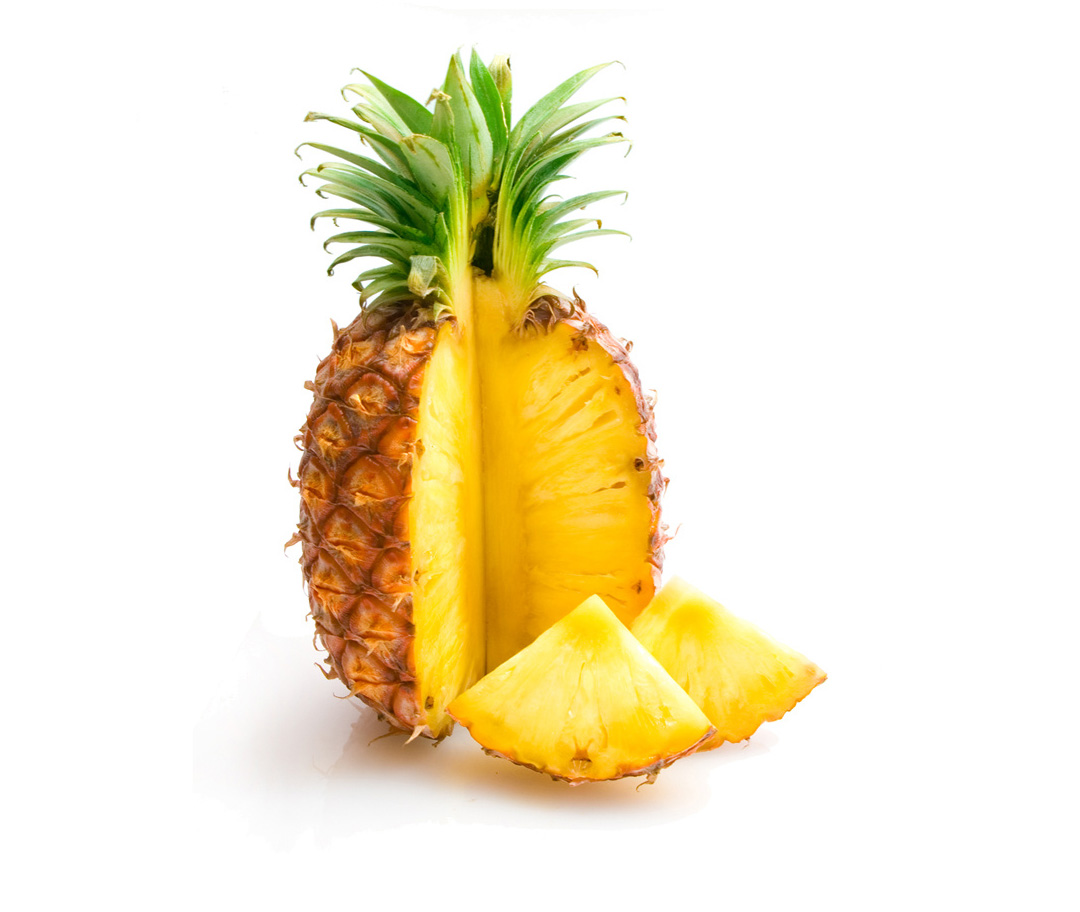
Pineapple is a sweet tropical fruit that is loaded with manganese and vitamin C, plus several B-vitamins and many other vitamins and minerals.
You can enjoy pineapple by itself or combine it with almost any other fruit or vegetable… pineapple is a great addition to salads, smoothies and raw vegan desserts including pies and ice cream.

Piña es una fruta dulce tropical cargada de manganeso y vitamina C, además de varias vitaminas B y muchas otras vitaminas y minerales.
Puedes disfrutar la piña solita o combinala con cualquiera otra fruta o vegetal… la piña es excelente en ensaladas, batidos, y postres crudiveganos incluyendo helado de piña.
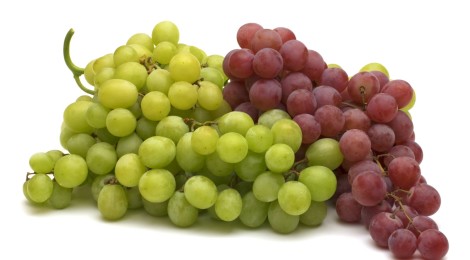
Grapes are high in antioxidants such as resveratrol, flavanols, flavonols, phenolic acids and carotenoids, as well as vitamins K and B2, and copper. Please choose organic grapes as conventionally-grown grapes are unusually-high in pesticides.

Las uvas son ricas en antioxidantes como el resveratrol, flavonoides, ácidos fenólicos, flavonoides y carotenoides, así como las vitaminas K y B2, y cobre. Por favor, elija uvas orgánicas como las uvas de cultivo convencional son muy altos en pesticidas.
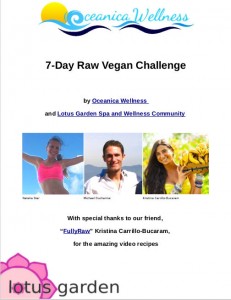 Click here (or click the image to the right) to download our 7-day raw vegan menu and shopping list
Click here (or click the image to the right) to download our 7-day raw vegan menu and shopping listWelcome to our 7-day Raw Vegan Challenge! We are so happy you joined us! It is time to try a beautiful healthy way of eating! This challenge will help you to start developing the habit of eating more fruits and vegetables, to avoid toxins and to reduce inflammation. The raw vegan lifestyle can help you with skin problems, digestion, weight management and it will definitely give you more energy!
“Vegan” means absolutely no animal product (meat, fish, eggs, and dairy). And “Raw” means uncooked. So you’ll be eating the foods that nature intended for human consumption… foods that are delicious in their natural form, and the easiest to digest.
During this challenge you can follow our 7-day meal plan. But don’t stress over following it exactly. You can add, subtract or substitute any raw fruit or vegetable that you choose. You can also modify the quantities to suit your appetite. Feel free to create your own recipes too! Make sure to fill up your fridge before the challenge… there is a shopping list at the end of our PDF!
Remember, you are stronger than this challenge and this challenge will make you stronger!
Peace & Love,
Natalia Star
Oceanica Wellness
Michael Ducharme
Lotus Garden Spa and Wellness Community
More than 90% water, plus many important nutrients including several B-vitamins, vitamin C, lycopene, amino acids, calcium, iron , magnesium and many more.
Grapes are high in antioxidants such as resveratrol, flavanols, flavonols, phenolic acids and carotenoids, as well as vitamins K and B2, and copper. Please choose organic grapes as conventionally-grown grapes are unusually-high in pesticides.
Pineapples are loaded with manganese and vitamin C, plus several B-vitamins and many other vitamins and minerals.
Vitamins B, C, E and K, plus calcium, iron, magnesium, phosphorus, potassium, sodium and zinc.
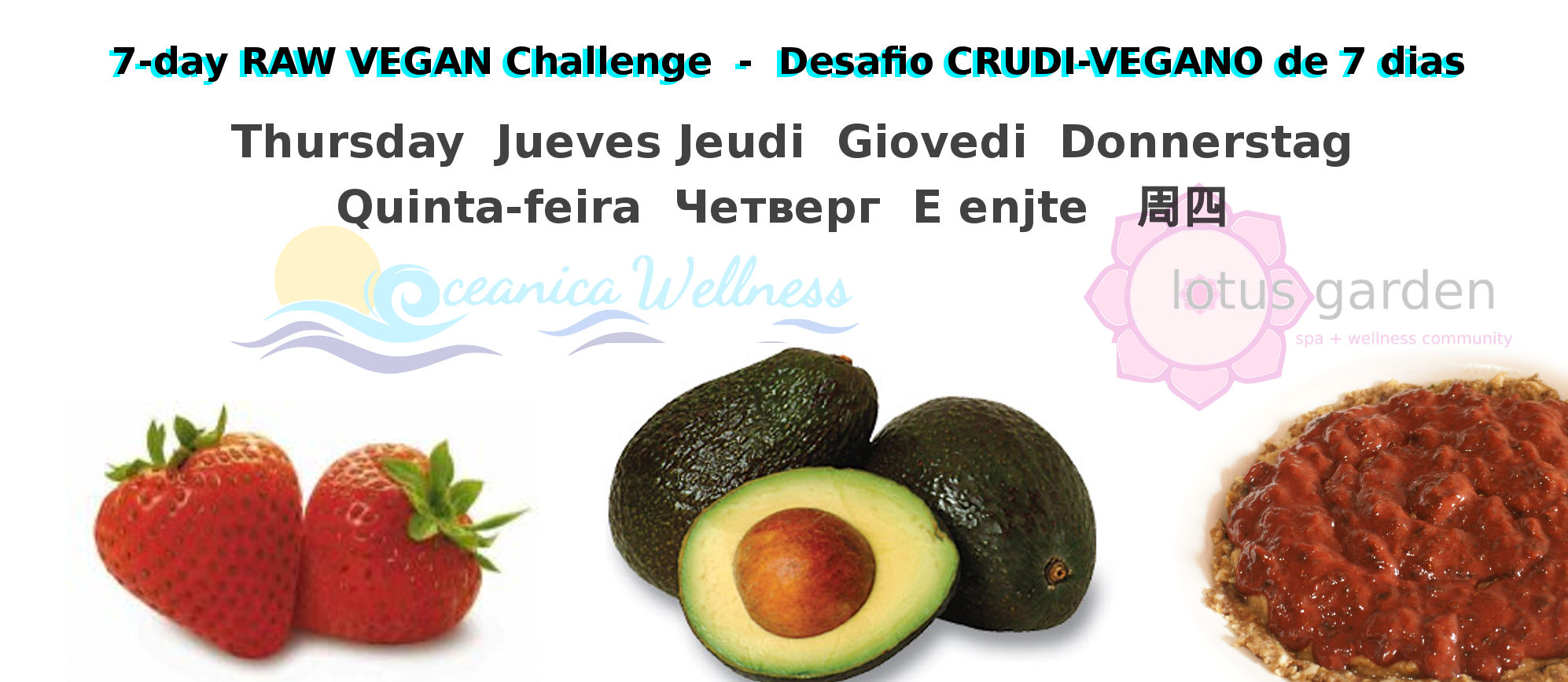
Lots of vitamin C, manganese, and essential unsaturated fatty acids. Strawberries also contain anti-inflammatory phytochemicals (such as polyphenols, flavonoids and phenolic acids) that help prevent both cancer and heart disease.
Avocados provide nearly 20 essential nutrients, including fiber, potassium, Vitamin E, B-vitamins such as folic acid. Avocados are high in healthy fats such as oleic acid, palmitic acid and linoleic acid, and studies have shown that consuming avocados regulates blood cholesterol (increasing HDL “good” cholesterol while decreasing LDL “bad” cholesterol)
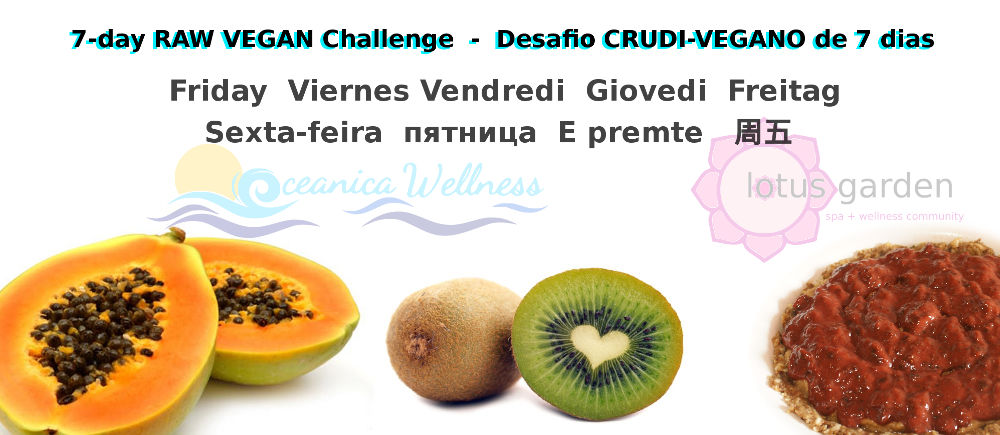
Papayas are loaded with vitamin C, plus vitamin A, potassium, magnesium and lots of other nutrients. Papayas are alkalizing and extremely easy to digest.
Kiwis are high in vitamin C, plus vitamins E and K, potassium and magnesium, and the carotenoids beta-carotene, lutein and zeaxanthin. Kiwis have been shown to prevent blood clotting as effectively as aspirin, with no side effects. The skin is edible and nutrient-dense.






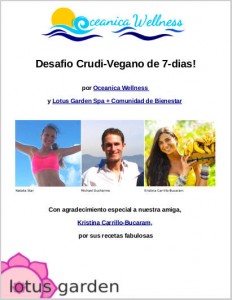
¡Bienvenid@ a nuestro Reto Crudi-Vegana de 7 días! ¡Estamos contentos de tenerl@ con nosotros! Es hora de probar una hermosa forma de comer! Este reto le ayudará a comenzar a desarrollar el hábito de comer más frutas y verduras, para evitar las toxinas y reducir la inflamación.
El estilo de vida crudi-vegana le puede ayudar con problemas de la piel, la digestión, control de peso y sin duda le dará más energía!
“Vegana” significa absolutamente ningún producto de origen animal (carne, pescado, huevos y productos lácteos). Y “Crudi” significa sin cocinar. Así que van a comer los alimentos que la naturaleza destina para el consumo humano… Los alimentos que son deliciosos en su forma natural, y los más fáciles de digerir.
Durante este desafío, puede seguir nuestro plan de comidas de 7 días. Pero no se estrese en seguirlo exactamente. Puede sumar, restar o sustituir cualquiera fruta o verdura cruda que usted elija. También puede modificar las cantidades para satisfacer su apetito. Siéntase libre de crear sus propias recetas también!
Asegúrese de llenar la nevera bien antes del desafío… hay una lista de compras al final de nuestro PDF!
Recuerde, usted es más fuerte que este reto y este reto le hará más fuerte!
Paz & Amor,
Natalia Star
Oceanica Wellness
Michael Ducharme
Lotus Garden Spa y Comunidad de Bienestar
Haga clic aquí para descargar nuestro menú vegana cruda y lista de compras de 7 días

Diabetes Mellitus is one of the world’s biggest killers. The word “diabetes” means “passing through” and “mellitus” refers to honey or the sweet taste of sugar. It happens that those with diabetes urinate more frequently, and that urine is loaded with sugar, but this is just one of many symptoms of diabetes. The other symptoms include blurry vision, increased appetite or thirst, and extreme weakness. These and still more symptoms merely indicate that you may look forward to a long list of terrible consequences of full-blown diabetes: heart disease, obesity, liver failure, difficulty breathing, erectile dysfunction, yeast infections, joint problems, nausea, vomiting, convulsions, gangrene and ulcers leading to the amputation of limbs, coma, memory loss, nerve damage, premature aging and unfortunately, the list goes on and on.
The medical community holds that there is no cure for diabetes, but there is evidence to suggest that diabetes is both preventable and reversible. My intention in sharing this information with you is that you will work together with your doctor to achieve the highest level of health, while using the fewest medications possible.
A diagnosis of diabetes is always classified as being either “Type 1”, “Type 2” or “gestational”. Type 1, according to the vast majority of doctors, is the pancreas’ complete inability to produce insulin, and therefore requires a lifetime of direct insulin injections. Type 1 diabetes is sometimes referred to as insulin-dependent diabetes mellitus (or IDDM) and was previously called “juvenile-onset diabetes”. The medical community has been forced to drop the latter name because of the great number of adults that are developing Type 1 diabetes, and the great number of children that are developing Type 2 diabetes. Type 2 diabetes, according to mainstream literature, is when the beta cells of the pancreas can be stimulated to produce insulin, meaning that the “lucky” patient can swap a lifetime of needles for a lifetime of pills. “Gestational” diabetes affects only pregnant women and their babies. Although the mainstream medical community rejects the idea of curing diabetes, many responsible physicians do recommend that their patients adopt a healthy diet and lifestyle to prevent diabetes or slow its progression.
There are several new and old treatment protocols that offer more than blind hope for those suffering with diabetes.
Dr. Robert O. Young is a modern-day champion in the fight against diabetes. A microbiologist, Dr. Young uses a high-powered microscope to perform live-cell analysis on human blood. This process allows him to record the movement of the living blood. Using this technology, he re-discovered what a French scientist named Antoine Béchamp(1,2) had discovered about 100 years ago: that a blood cell can actually become a bacterial cell or a fungus cell (and can convert back to a regular blood cell) depending on the pH of the fluid that surrounds the cell. Both Béchamp and Young observed tiny organisms called microzymas, which can morph or transform themselves through a process called pleomorphism. Béchamp’s discoveries were mostly ignored for a century as the world erroneously followed Louis Pasteur’s Germ Theory. Pasteur blamed “external” invaders that could be killed with heat (pasteurization) and/or drugs (antibiotics). He ignored the possibility that disease was created internally. The Germ Theory lives on today, as it is compatible with big business: pasteurization allows mass-production of animal products in disgracefully dirty conditions, and the “external threat” of deadly germs creates a huge demand for pharmaceuticals. Recognizing the possibility that “the enemy is created within”, one is empowered to take personal responsibility for preventing and reversing one’s disease. That real healing can happen through proper diet and lifestyle is the nightmare of Big Pharma and Big Food. Dr. Young’s book, The pH Miracle for Diabetes is a blueprint for preventing and reversing diabetes. I have read, and thoroughly agree with the essence of Dr. Young’s message. In the book, Dr. Young describes the results that he observed in two small clinical trials, and provides a wealth of knowledge that he accumulated over many years of scientific study. His wife, Shelly Redford Young, provides 125 pages of recipes that can help anyone to improve their diet. Shelly’s recipes are nutritious, delicious and easy-to-follow. (Although I must confess to not having tried all of them since I normally create my own recipes with the freshest organic fruits and vegetables available to me.) I would recommend that you buy his book if you or someone that you care about is diabetic, or on the road to becoming one.
Dr. Davis is a cardiologist that has seen thousands of patients with both heart disease and diabetes. Dr. Davis’ own clinical experience confirms what the medical literature already knew: that diabetes and heart disease often go hand-in-hand. In fact, that is an understatement. Having diabetes makes you about 60% more likely to suffer heart disease. Dr. Davis has authored the book “Wheat Belly”, which explains in great detail, the correlation between these two diseases. As the title of the book suggests, Dr. Davis recommends drastically-reducing our consumption of carbohydrates, and eliminating wheat altogether. According to Dr. Davis, a slice of whole wheat bread will spike your blood sugar more than a Snickers bar, and even more than eating a teaspoon of pure table sugar. Throughout the book, Dr. Davis does not spare any detail. He thoroughly describes the sequence of events from the instant that a carbohydrate enters your mouth, through the entire digestive tract, the creation of several types of lipoproteins and the formation of AGE’s (advanced glycation end products). Lipoproteins are proteins that carry lipids. They are often referred to (erroneously) as “cholesterol”. LDL stands for Low Density Lipoprotein, and is often referred to (again, erroneously) as “bad cholesterol”. Dr. Davis is crystal clear on this issue: LDL is only problematic when the LDL molecules are smaller than 25.5 nanometers. The more wheat, sugar and other carbohydrates we eat, the more of these “small” LDL molecules are created. Davis is equally descriptive on AGE’s, which are the true cause of aging. He explains that diabetics are among the unhealthiest people in this regard, as their high rate of glycation indicates that they are aging faster than the rest of us. He does not suggest that aging can be halted completely, but he does prescribe a method of slowing down the process as much as possible. Yes, eliminate wheat, and reduce sugar and grains. Doing so will protect you from premature aging, as well as diabetes and heart disease, according to Dr. Davis.
The Kuna tribe of Panama also knows that diabetes is reversible, but they made this discovery without the benefit of a microscope. The Kuna rely on the advice of “Nele”, the Kuna doctor. I met Nele over a decade ago and have learned some of the Kuna’s most precious secrets. Nele prescribes a list of ten medicinal plants, all found abundantly in Panama, to reverse diabetes. Nele does not emphasize the value of any one plant, but rather, the synergistic value of many plants. In her words “trust not the plant, but the creator of the plants… attack the enemy not with one warrior but with many”. I have personally witnessed the dramatic and sustained lowering of blood sugar in Type 1 diabetics, after drinking just one cup of tea, made from just one of the ten plants prescribed by Nele. Although these observations appear miraculous to the observer (in this case, me), this type of “anecdotal evidence” is often disregarded by the medical community, which prefers to base itself solely on (expensive) randomized clinical trials. Both Nele and I are more than willing to cooperate in such a trial, but as of yet we are not connected with any diabetes clinic.

The Lotus Lifestyle is a system that I created for living in balance, easily. You can read about The Lotus Lifestyle in detail if you wish. But for the purpose of this article, here is a short summary: There are nine essential elements to a healthy lifestyle: love, clean air, sunshine, natural spring water, an alkalizing (plant-based) diet, staying wiggly, detoxifying, meditation and dreaming. The simpler a plan, the easier it is to implement, so I have organized my plan into an 8-petaled lotus flower, which symbolizes beauty and balance… each of the eight petals symbolizes one of the elements that is necessary for obtaining wellness, and each springs from the core of the lotus, which is love itself. The nine essential elements that I describe in The Lotus Lifestyle are available to all, and it is possible to partake without spending a penny. The nine elements of The Lotus Lifestyle work synergistically to create a healthy, alkaline environment for the cells. My plan agrees with the good doctors (including Young and Davis) that vegetables and herbs are among the best sources nutrients, while grains and animal products are among the worst (because they acidify, and lead to diabetes). But my plan also emphasizes the importance of breathing clean air as deeply as possible, to increase the oxygen and eliminate acidic waste products from the cells. The other ‘petals’ of The Lotus Lifestyle, such as getting sunshine, clean water, and staying wiggly, are simple methods of keeping all systems in balance and functioning as nature intended.
The four “alternative” plans presented here all fit together perfectly without contradictions. Dr. Young (so far) has not tested the specific plants prescribed by Nele. But Dr. Young does rely heavily on green vegetables and medicinal herbs to alkalize the body, such that the sick cells can morph back into healthy cells, thus reversing the illness. I am confident that if Dr. Young (or another microbiologist with a similar willingness to challenge the mainstream belief) were to observe the effects of Nele’s herbs under a microscope, the images would confirm that the herbs do work synergistically to alkalize the blood and to support cellular healing. The diet plan contained within my Lotus Lifestyle is one that alkalizes the body, allowing it to heal itself in the manner described in detail by Dr. Young. My diet plan fits equally well with Dr. Davis’ advice, as I do not recommend any grains or sugars other than those contained in whole fruits and vegetables. Even the mainstream doctors recommend “a healthy diet and lifestyle”, and my plan offers that precisely. Notes and Links
Cacao is among the most famous plants on Earth. Its name comes from the Greek, and means “food of the gods”. Cacao was used and cultivated by ancient Central American indigenous tribes such as the Mayas, Aztecs and Kunas as currency. Their abundant gold was used as a mere decoration as it could not be as valuable as that which produced health.
Modern scientists are re-discovering the many medicinal uses of antioxidant-rich cacao, including its ability to fight cancer, heart disease, type 2 diabetes and depression, while stimulating cognitive function, improving memory and intelligence.
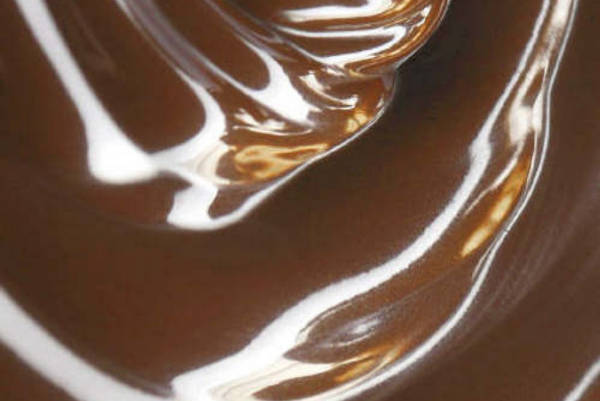
Cacao is the most important component in the production of chocolate. While commercial chocolates often contain copious amounts of sugar, cow milk and other addictive and toxic substances, it is certainly possible to produce a high quality chocolate using only healthy ingredients like cacao, coconut, and a natural sweetener like stevia, honey or maple syrup.
A 2012 study published in the New England Journal of Medicine found a “close, significant linear correlation between chocolate consumption per capita and the number of Nobel laureates”. (1)
Other recent studies have shown a positive effect on cholesterol, cough, weight loss, eczema, heart disease, high blood pressure and skin care.
In my wellness center, several female clients reported an absence of PMS symptoms following a chocolate therapy administered prior to the expected onset of the monthly symptoms. This chocolate therapy consisted of painting dark chocolate sauce on the patient from head to toe, allowing the skin to absorb the nutrients, as well as inhalation of the chocolate aroma, and a small amount of this same chocolate mixture was consumed.
Chocolate has long been considered an aphrodisiac and a mood-enhancer. Raw cacao stimulates the production of endorphins, dopamine, and serotonin, important neurotransmitters that block pain while creating pleasure and relaxation. Endorphins are our natural pain relievers; when pain suddenly disappears, a feeling of euphoria takes its place. Dopamine produces a feeling of joy with heightened focus and attention. Serotonin is our natural anti-depressant and it is important for relaxation and sleep. Each of these neurotransmitters are needed for good physical and mental health. Higher-than-normal levels of these neurotransmitters is likely to produce a feeling of intense pleasure and euphoria.
Interestingly, when forced to choose between chocolate and sex, 22 percent of women said they’d prefer chocolate. A survey of 2000 people found that alcohol, chocolate and sex were the three most difficult things to forgo. (2)
It is important to keep both sides of this coin in proper perspective. While decreasing pain and increasing both pleasure and relaxation are normally welcomed benefits, relying on any one nutrient to stimulate these natural functions can lead to addiction and unpleasant withdrawal symptoms if consumption ceases. In other words, cacao may be considered a medicine, and it is important to regulate the dosage. An excess external stimulation may cause the body to under-produce on its own, which would explain the withdrawal symptoms.
The Chicago Sun Times reported that people who suffer extreme depression have an irregular production of phenylethylamine or PEA, an amphetamine that stimulates dopamine receptors and increases mental alertness, pulse, blood pressure and blood sugar levels. When we fall in love, our brain naturally releases phenylethlamine, producing so much pleasure that it can be addictive. The heartbroken may self-medicate by binging on chocolate since chocolate is high in phenylethylamine.
Theophylline is a stimulant of the heart and central nervous system, relaxes the bronchial smooth muscles, and may be effective in preventing and treating apnea in premature infancy.
Anandamide is an endocannabinoid. Endocannabinoids occur naturally in the brain, but are most concentrated in the cannabis plant, and to a much lesser extent in cacao.
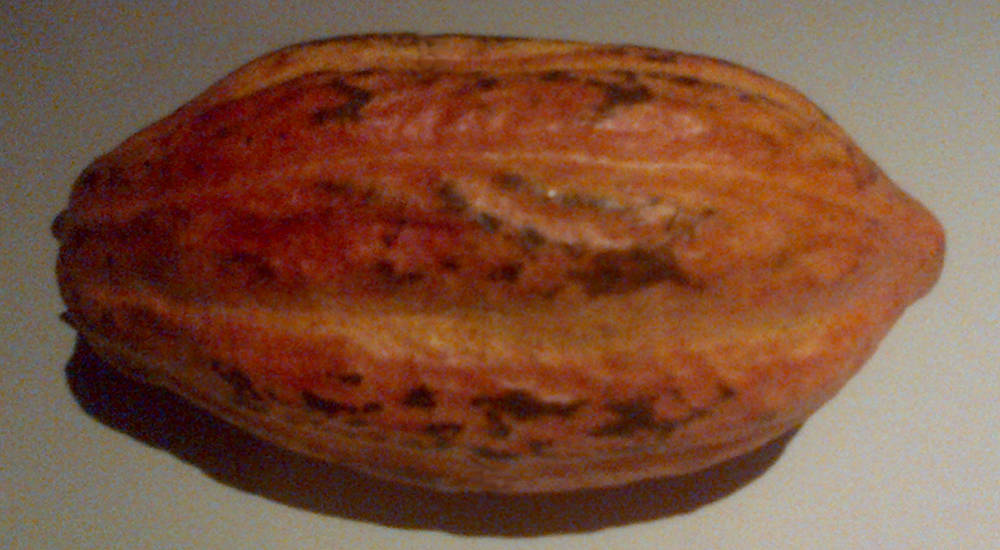
Pictured above is an entire cacao pod, which grows directly from the trunk of a tree in Central America.
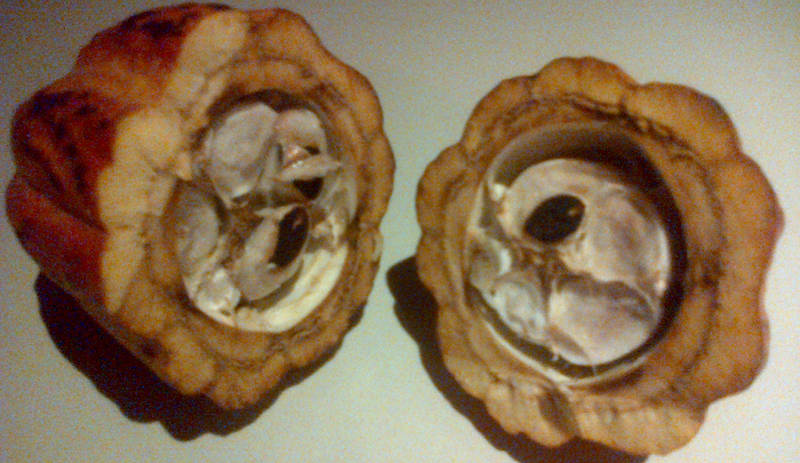
The picture above shows the cacao pod sliced in half, revealing the seeds covered in a sweet gooey white gel.
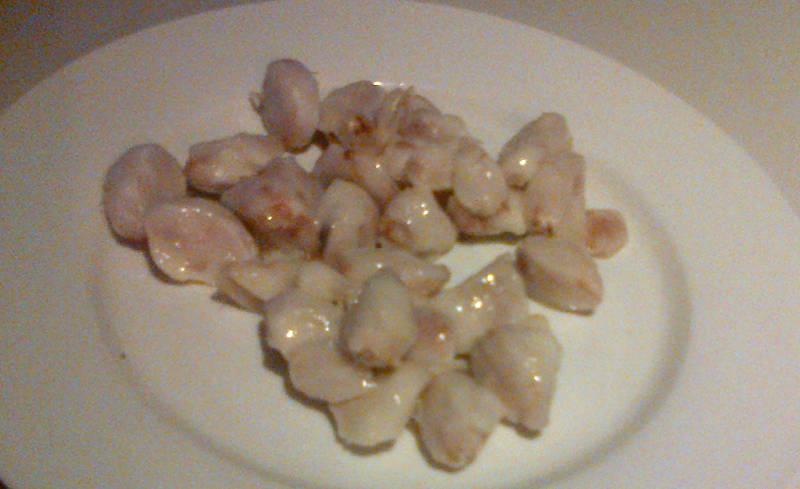
Pictured above are the raw seeds covered in white slimy gel. This sweet gel may be the key to prevention of cancer and heart disease as it is consumed by the indigenous tribe that does not suffer either of these degenerative diseases. There are almost no studies on the consumption of the gel, most probably because developed countries normally only receive the processed cacao and have never had access to the fruit in its raw form.
The scientific name of the chocolate fruit is “Cacaotero Theobroma”. Its chemical composition includes a large number of vitamins, amino acids and other phyto-nutrients… over 300 compounds in all. The flavor components include polyphenols, aliphatic esters, unsaturated aromatic carbonyls, pyrazines, diketopiperazines, and theobromine.
Per 100 grams, the seed contains 456 calories, 3.6 grams of water, 12.0 grams of protein, 46.3 grams of fat, 34.7 grams of total carbohydrate, 8.6 grams of fiber, 106 mg of calcium, 537 mg phosphorus, 3.6 mg iron, 30 mg beta-carotene, 0.17 mg of thiamine (Vitamin B1), 0.14 mg riboflavin (Vitamin B2), 1.7 mg niacin (Vitamin B3), and 3 mg ascorbic acid (Vitamin C).
Wealth of India reported that the edible pulp of the fruit contains 79.7–88.5% water, 0.5–0.7% albuminoids, astringents, etc.; 8.3–13.1% glucose, 0.4–0.9% sucrose, a trace of starch, 0.2–0.4% non-volatile acids (as tartaric), 0.03% Fe2O3 and 0.4% mineral salts (K, Na, Ca, Mg).
Raw seeds contain 0.24 mg/100 g thiamine, 0.41 riboflavin, 0.09 pyridoxine, 2.1 nicotinamide, and 1.35 pantothenic acid.
Cocoa also contains about 18% proteins, fats (cocoa butter), amines and alkaloids including theobromine (0.5 to 2.7%), caffeine (ca 0.25% in cocoa; 0.7 to 1.70 in fat-free beans, with forasteros containing less than 0.1% and criollos containing 1.43 to 1.70%), tyramine, dopamine, salsolinol, trigonelline, nicotinic acid, and free amino acids; tannins; phospholipids; and more.
The seeds, leaves and roots contain alkaloids theobromine and caffeine which has diuretic and vasodilator. Antitumor activity was found in the root and bark. The seeds contain fat (cocoa butter) are used in pharmacy as an emollient and for making ointments and creams. It is helpful in treating dry skin, burns, dandruff, dysentery, measles, and even snakebites, according to folk healers. Overall, cocoa is slightly tonic and stimulant, although in large doses or in sensitive individuals, can cause insomnia and tachycardia. (5)
To compare the amount of caffeine in a 6 oz cup of various beverages, I rely on information from Tyler and Palotti (6,7).
This recipe takes less than five minutes to make, and it’s nutritious and delicious:
Wash and chop everything. Juice the limes. Toss all ingredients into a high power blender and blend for 90 seconds for warm delicious soup. You can draw a heart in the soup before serving it if you desire.
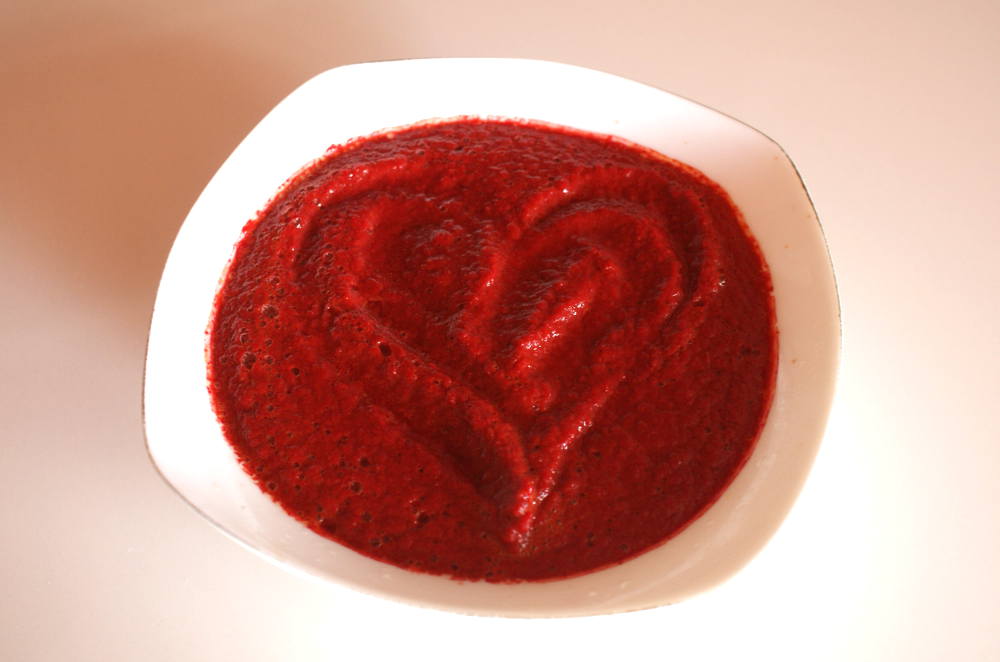
Lavar y picar todo. Exprime el jugo de las limas o limones. Mezcle todos los ingredientes en una licuadora de alta potencia y licuar durante 90 segundos para una deliciosa sopa calida. Puedes dibujar un corazoncito en la sopa antes de servirla si deseas.

I wholeheartedly agree with the great majority of this book. I recommend buying it or borrowing it from your local library, as it is filled with valuable information, studies and anecdotes from real people that have achieved extraordinary results by eating a diet of mostly fruit. I consider it to be among the best health books on the market.
Here are just a few selected quotes:
Will eating raw make me healthy?
A proper raw diet will result in improved health, but I must emphasize that the body, not food, creates health. Food does not build; the body builds. Food does not cleanse; the body cleanses. Good health, after all, is the result of a healthy lifestyle.
The raw diet is but one component of healthful living. Adequate rest and sleep, regular, vigorous physical activity, plenty of fresh air, sunlight, a positive outlook on life, and many other factors are also essential to creating good health. (Page 239.)
“We propose that there is only one illness: toxemia, this is a condition of unclean blood and tissues, caused primarily by unchecked diet and lifestyle. Unchecked, toxemia and its attendant enervation (nervous exhaustion) get progressively worse over the years, leading to all manner of symptoms.” (Page 257.)
Dr. Graham tackles the popular issue of weight loss. When people switch to a diet that is exclusively raw, “the first dramatic change that people frequently notice is a rapid and dramatic loss of weight”. Since most Westerners are indeed overweight to begin with, most people are delighted with the change. Other folks see themselves getting too thin, and sometimes even mistakenly believe they are losing muscle.
“what actually happens…is that we lose so much of the padding (fat) around our muscles and also the fat marbled within our muscles. In addition, on a raw diet, we begin to lose the water that we once retained to dilute toxins. This water also added to the appearance of inflated muscles. Many people mistake this excess fat and water as part of their muscle.”
“No diet exists that results in muscle loss or muscle gain. If there were a diet that resulted in muscle gain, bodybuilders would be found in the kitchen instead of the gym. .. In spite of what we have all been told, consuming protein (or any other nutrient) will not assist the muscle-building process.” (page 148)
On page 156, Dr. Graham states that digestive, absorptive, or assimilative problems could contribute to unwanted weight loss in new raw fooders, yet he believes these to be the exception rather than the rule, and that these problems will quickly correct themselves when the person switches away from high-fat, cooked, processed and toxic foods unsuitable to our physiological design are moved from the diet. I can not argue with Graham’s extensive clinical experience, but I believe that digestive, absorptive, and assimilative problems are extremely common (although widely under-diagnosed) due to the cooking of food and the consumption of animal products.
If Dr. Graham mentions fasting in this book, then I missed it. It is understandable that Dr. Graham would not discuss fasting in a book on the opposite of fasting, eating. One of the main outcomes of a water fast is the elimination of intestinal plaque, which blocks the proper absorption of nutrients in the small intestine. Here is a video of Dr. Graham speaking on fasting to recover health:
(Dr. Graham discusses the benefits of fasting after 13 minutes.)